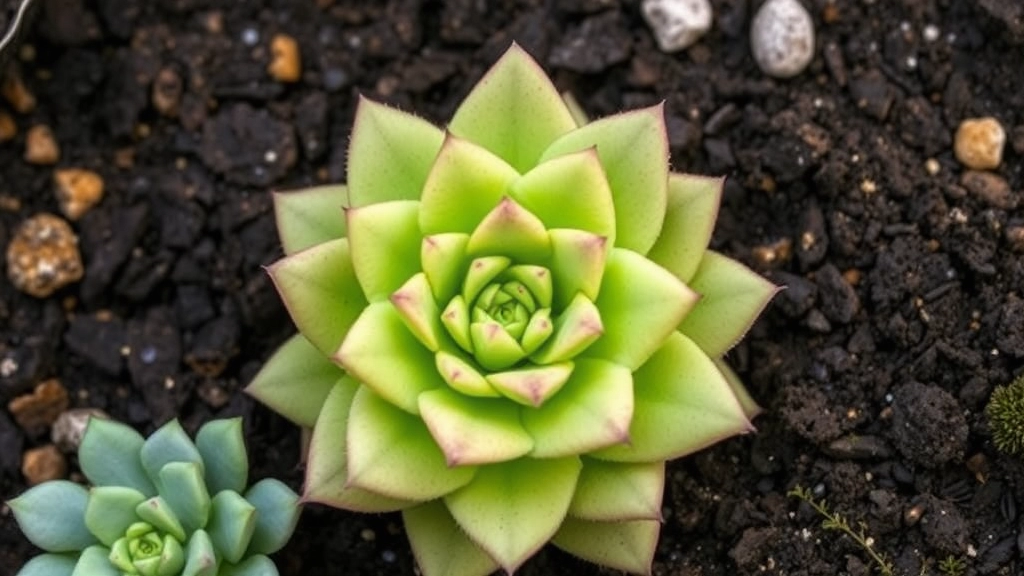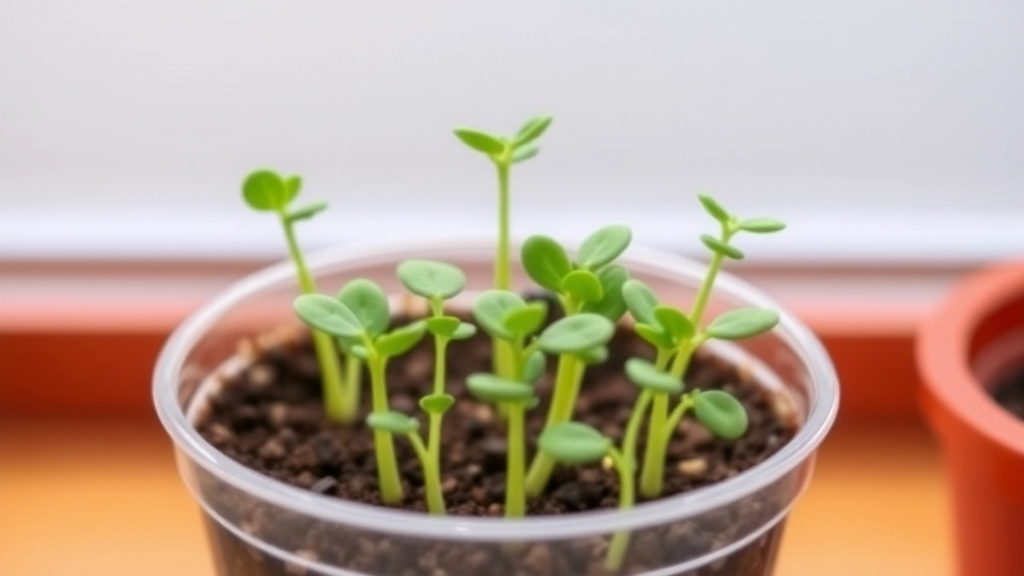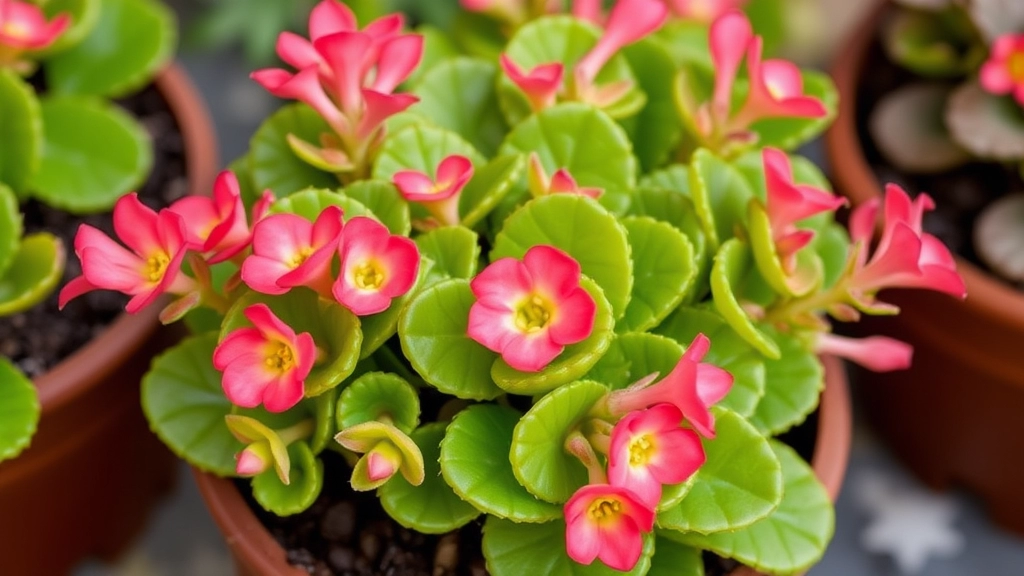Mastering the Care and Propagation of the Kalanchoe Plant
If you’re looking to master the care and propagation of the Kalanchoe Plant, also known as the Mother of Thousands, you’re in the right place. This unique succulent is not only visually striking but also incredibly rewarding to grow. In this guide, I’ll walk you through everything from optimal light and temperature to soil and watering techniques, ensuring your plant thrives.
We’ll delve into how to prune and control its rapid growth, the best methods for propagating from plantlets, and managing its invasiveness in your garden. Plus, I’ll cover common problems and their solutions, as well as important safety considerations for pets and humans. Let’s get started on making your Kalanchoe Plant Mother of Thousands flourish!
When caring for your Mother of Thousands (Kalanchoe daigremontiana), you may wonder about the ideal conditions to ensure its thriving growth.
### Light Requirements
This succulent loves bright, indirect sunlight. Here’s what to keep in mind:
– **Direct sunlight** can scorch the leaves, leading to unsightly brown patches.
– **Filtered light** is perfect, allowing the plant to soak in energy without the risk of damage.
– A **south or east-facing window** is often the best spot for your plant.
### Temperature Preferences
Temperature plays a crucial role in the health of your Mother of Thousands. Aim for:
– **Optimal range:** 20-25°C (68-77°F) during the day.
– **Nighttime temperatures:** Can drop to around 10-15°C (50-59°F).
– **Avoid extreme cold:** Temperatures below 5°C (41°F) can be detrimental.
For more detailed care tips, you might find this [complete guide to growing Kalanchoe Mother of Thousands](https://planthq.org/complete-guide-to-growing-kalanchoe-mother-of-thousands/) useful. Additionally, if you’re interested in other Kalanchoe species, you can explore [different Kalanchoe species for your garden](https://planthq.org/explore-different-kalanchoe-species-for-your-garden/).
Best Soil and Watering Techniques for Mother of Thousands

So, you’ve got your Mother of Thousands and you’re wondering how to keep her thriving, right?
Soil Requirements:
- Well-Draining Soil: This plant loves to have its roots dry out between waterings. A mix of potting soil and sand or perlite works wonders.
- pH Level: Aim for a slightly acidic to neutral pH (around 6.0 to 7.0). This helps the plant absorb nutrients better.
- Container Choice: If you’re using pots, make sure they have drainage holes. This prevents water from pooling at the bottom, which can lead to root rot.
Watering Techniques:
- Frequency: Water your Mother of Thousands every 2-3 weeks, allowing the top inch of soil to dry out completely before the next watering.
- Watering Method: When you do water, give it a good soak. Ensure the water drains out of the bottom. This encourages deep root growth.
- Seasonal Changes: In winter, cut back on watering. The plant goes dormant and needs less moisture.
Tips to Remember:
- Always check the soil moisture before watering. Stick your finger in the soil—if it feels dry, it’s time to water.
- Avoid letting the plant sit in water. Standing water can lead to mushy roots and a dead plant.
Pruning and Controlling Plant Growth
As we delve into the essential practices for maintaining your Mother of Thousands, it’s crucial to consider how pruning and controlling plant growth can enhance its overall health and appearance.
Why Prune?
Pruning is vital for several reasons:
- Encouraging Growth: Regular pruning stimulates new growth, making your plant more vibrant.
- Preventing Overcrowding: It helps manage the density of the plant, allowing for better air circulation and light penetration.
- Aesthetic Appeal: A well-pruned plant looks tidy and more visually appealing.
When to Prune
Timing is key when it comes to pruning your Mother of Thousands. The best time to prune is during the growing season, typically in spring or early summer. This allows the plant to recover quickly and promote new growth.
How to Prune
Here are some straightforward steps to effectively prune your Mother of Thousands:
- Gather Your Tools: Use sharp, clean scissors or pruning shears to avoid damaging the plant.
- Identify the Areas to Cut: Look for dead leaves, spent flowers, or overcrowded stems.
- Make Clean Cuts: Trim just above a leaf node to encourage branching.
- Remove Offsets: If you notice any plantlets that are too crowded, gently remove them to allow for better spacing.
Controlling Growth
Controlling the growth of your Mother of Thousands is equally important to prevent it from becoming invasive. Here are some practical tips:
- Limit Watering: Overwatering can lead to excessive growth. Allow the soil to dry out between waterings.
- Use Containers: Growing in pots can help contain the plant’s spread and make it easier to manage.
- Regular Monitoring: Keep an eye on the plant’s growth and adjust care practices as needed.
For more detailed information on how to manage your plant, check out our Mother of Thousands care guide and our complete care guide for Kalanchoe Tubiflora.
Propagation: How to Grow from Plantlets

Are you looking to expand your collection of Mother of Thousands?
Propagation through plantlets is a straightforward and rewarding process. These little wonders are not just delightful to behold; they also make it easy to multiply your plants without much fuss.
Understanding Plantlets
Mother of Thousands produces tiny plantlets along its leaf edges. These plantlets can be easily removed and propagated, leading to new, vibrant plants.
Steps for Successful Propagation
- Identify Healthy Plantlets
Look for mature plantlets that have developed roots. These are usually positioned at the leaf’s edge. - Remove with Care
Use a clean, sharp knife or scissors to gently detach the plantlet from the mother plant. Ensure you don’t damage the leaf. - Let Them Callous
Place the removed plantlets on a dry surface for a few hours. This helps to prevent rot when you plant them. - Prepare the Soil
Use a well-draining soil mix, ideally a cactus or succulent blend. This ensures the plantlets won’t sit in water. - Plant the Plantlets
Make small holes in the soil and place the plantlets in, covering their roots lightly. - Water Sparingly
After planting, give them a light misting. Avoid overwatering as this can lead to rot. - Provide Optimal Conditions
Place the pots in a warm spot with indirect sunlight. This encourages growth without stressing the young plants.
Monitoring Growth
Keep an eye on your plantlets over the next few weeks. You should see new growth emerging, indicating that they are establishing themselves well.
Managing Invasiveness in Gardens
As we delve deeper into caring for your Mother of Thousands, it’s crucial to address a common concern: its invasive nature. Many gardeners worry about how to keep this beautiful plant in check while still enjoying its unique charm.
Understanding Invasiveness
Mother of Thousands (Kalanchoe daigremontiana) is known for its rapid growth and ability to propagate easily. This means it can quickly take over your garden if not managed properly. Here are some practical steps to help you maintain control:
- Regular Monitoring: Keep an eye on your plant’s growth. Inspect your garden weekly to catch any new plantlets before they spread too far.
- Containment Strategies:
- Use Containers: Growing Mother of Thousands in pots can limit its spread. Ensure pots have drainage holes for optimal health.
- Physical Barriers: Consider using garden edging to prevent roots from extending into unwanted areas.
- Pruning: Regularly prune back any overgrowth. This not only keeps the plant manageable but also encourages healthier growth.
- Removal of Offshoots: Be diligent about removing any plantlets that fall off and begin to root. Dispose of them properly to prevent re-establishment.
It’s important to remember that managing invasiveness doesn’t mean you have to compromise on aesthetics. By implementing these strategies, you can enjoy the beauty of Mother of Thousands while keeping it in check. For more detailed advice, check out our complete care guide for Kalanchoe Tubiflora and learn how to propagate Kalanchoe Mother of Thousands easily.
Common Problems and How to Fix Them

So, you’ve got your Mother of Thousands thriving, but then you notice something off.
Maybe the leaves are turning yellow, or your plant isn’t growing as it should.
Don’t worry; you’re not alone.
Let’s dive into some common issues and how to tackle them.
Yellowing Leaves
If your plant’s leaves are turning yellow, it could be a sign of overwatering or poor drainage.
- Check the soil: If it feels soggy, cut back on watering.
- Improve drainage: Use a pot with holes and consider adding perlite to your soil mix.
Wilting or Drooping
Wilting usually means your plant is thirsty, but it can also signal root rot.
- Thirsty?: Give it a good drink, but don’t drown it.
- Root rot?: Remove the plant from its pot and inspect the roots. Trim any mushy bits and repot in fresh soil.
Pests
Pests like mealybugs or aphids can be a real pain.
- Spot them early: Look for white cottony spots or sticky residue.
- Get rid of them: Use a cotton swab dipped in rubbing alcohol or a gentle insecticidal soap.
Stunted Growth
If your Mother of Thousands seems to be on a growth strike, it might be lacking nutrients.
- Feed it: A diluted succulent fertilizer can give it a boost.
- Repot: If it’s been in the same pot for a while, it might need more space.
Leaf Drop
Dropping leaves can be alarming, but it’s often a natural part of the plant’s life cycle.
- Environmental changes: If you’ve moved it recently, give it time to adjust.
- Check light levels: Too much or too little light can also cause leaf drop.
Toxicity and Safety Considerations for Pets and Humans
As we delve into the care of the Mother of Thousands, it’s crucial to address a pressing concern: its toxicity.
Many plant enthusiasts wonder, “Is Mother of Thousands safe for my pets and children?”
The answer is nuanced. While this striking succulent is a beautiful addition to any garden, it contains compounds that can be harmful if ingested.
Key Toxicity Points:
- Toxic to Pets: The plant is toxic to cats and dogs. Symptoms of ingestion may include vomiting, diarrhoea, and lethargy. Always monitor your pets around this plant.
- Human Safety: For humans, the plant can cause skin irritation or gastrointestinal discomfort if ingested. It’s best to keep it out of reach of small children.
- Handling Precautions: When pruning or handling the Mother of Thousands, consider wearing gloves. This can help prevent any skin irritation from its sap.
To ensure a safe environment, consider these practical tips:
- Placement: Position the plant in areas that are inaccessible to pets and children.
- Education: Teach children about the plant and why they should avoid touching or tasting it.
- Regular Checks: Keep an eye on your garden. If you notice any signs of your pets showing interest in the plant, take action immediately.
By being proactive, you can enjoy the beauty of the Mother of Thousands while ensuring a safe space for your loved ones. For more information on the toxicity and safety tips of Kalanchoe plants, visit our detailed guide. Additionally, you can learn about the care and propagation of the Mother of Thousands to keep your plant thriving.
FAQs on Kalanchoe Plant Mother Of Thousands
What type of soil is best for Mother of Thousands?
Well-draining soil is crucial for Mother of Thousands. A mix of potting soil and sand or perlite is ideal. Aim for a pH level of 6.0 to 7.0 to help the plant absorb nutrients better.
How often should I water my Mother of Thousands?
Water your Mother of Thousands every 2-3 weeks, allowing the top inch of soil to dry out completely before the next watering. In winter, reduce the frequency as the plant goes dormant.
How do I propagate Mother of Thousands?
Propagation is simple through plantlets that grow along the leaf edges. Remove mature plantlets with roots, let them callous for a few hours, and then plant them in well-draining soil. Water sparingly and place in a warm spot with indirect sunlight.
Why are the leaves of my Mother of Thousands turning yellow?
Yellowing leaves can indicate overwatering or poor drainage. Check the soil moisture and improve drainage by using a pot with holes and adding perlite to the soil mix.
What should I do if my Mother of Thousands is wilting or drooping?
Wilting can mean the plant is thirsty or suffering from root rot. Water it thoroughly if the soil is dry, but inspect the roots and trim any mushy parts if root rot is suspected. Repot in fresh soil if needed.
How do I deal with pests on my Mother of Thousands?
Look for signs of pests like white cottony spots or sticky residue. Use a cotton swab dipped in rubbing alcohol or a gentle insecticidal soap to remove pests like mealybugs or aphids.
What causes stunted growth in Mother of Thousands?
Stunted growth can be due to nutrient deficiency or the need for more space. Use a diluted succulent fertilizer to boost growth and consider repotting if the plant has outgrown its current pot.
Why is my Mother of Thousands dropping leaves?
Leaf drop can be a natural part of the plant’s life cycle or due to environmental changes. Ensure the plant has stable light levels and give it time to adjust if recently moved.
References
-
The Spruce – Mother of Thousands Plant Profile
-
Gardening Know How – Mother of Thousands Care
-
House Plants Expert – Mother of Thousands
